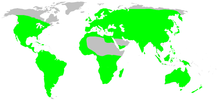This article may require copy editing for grammar, style, cohesion, tone, or spelling. (May 2024) |
| Trombiculidae | |
|---|---|

| |
| Trombiculid mite larva | |
| Scientific classification | |
| Domain: | Eukaryota |
| Kingdom: | Animalia |
| Phylum: | Arthropoda |
| Subphylum: | Chelicerata |
| Class: | Arachnida |
| Order: | Trombidiformes |
| Suborder: | Prostigmata |
| Infraorder: | Anystina |
| Superfamily: | Trombidioidea |
| Family: | Trombiculidae Ewing, 1929[1] |
| Type genus | |
| Trombicula Berlese, 1905
| |
| Genera[2] | |
| |

| |
| The distribution of trombiculid species, which is nearly everywhere in the world. | |
Trombiculidae (/trɒmbɪˈkjuːlɪdiː/), commonly referred to in North America as chiggers and in Britain as harvest mites, but also known as berry bugs, bush-mites, red bugs or scrub-itch mites, are a family of mites.[3] Chiggers are often confused with jiggers – a type of flea. Several species of Trombiculidae in their larva stage bite their animal host and by embedding their mouthparts into the skin cause "intense irritation",[4] or "a wheal, usually with severe itching and dermatitis".[5][6][7] Humans are possible hosts.
Trombiculidae live in forests and grasslands and are also found in the vegetation of low, damp areas such as woodlands, berry bushes, orchards, along lakes and streams, and even in drier places where vegetation is low, such as lawns, golf courses, and parks.[8] They are most numerous in early summer when grass, weeds, and other vegetation are heaviest. In their larval stage, they attach to various animals, including humans, and feed on skin, often causing itching. These relatives of ticks are nearly microscopic, measuring 400 μm (1/60 of an inch) and have a chrome-orange hue.[9][10] There is a marked constriction in the front part of the body in the nymph and adult stages. The best known species of chigger in North America[11] is the hard-biting Trombicula alfreddugesi of the Southeastern United States, humid Midwest[12] and Mexico. In the UK, the most prevalent harvest mite is Neotrombicula autumnalis, which is distributed through Western Europe to Eastern Asia.[13]
Trombiculid mites go through a lifecycle of egg, larva, nymph, and adult.[14] The larval mites feed on the skin cells of animals. The six-legged parasitic larvae feed on a large variety of creatures, including humans, rabbits, toads, box turtles, quail, and even some insects. After crawling onto their hosts, they inject digestive enzymes into the skin that break down skin cells. They do not actually "bite", but instead form a hole in the skin called a stylostome and chew up tiny parts of the inner skin, thus causing irritation and swelling. The itching is accompanied by red, pimple-like bumps (papules) or hives and skin rash or lesions on a sun-exposed area. For humans, itching usually occurs after the larvae detach from the skin.[15]
After feeding on their hosts, the larvae drop to the ground and become nymphs, then mature into adults, which have eight legs and are harmless to humans. In the postlarval stages, they are not parasitic and feed on plant material. The females lay three to eight eggs in a clutch, usually on a leaf or among the roots of a plant, and die by autumn.[15]
- ^ "Trombiculidae Ewing, 1929 (Family)". SysTax - database query. Universität Ulm. Retrieved 2009-03-06.
- ^ Shatrov, Andrey B.; Kudryashova, Naina I. (2008). "Taxonomic ranking of major trombiculid subtaxa with remarks on the evolution of host-parasite relationships (Acariformes: Parasitengona: Trombiculidae)". Annales Zoologici. 58 (2): 279–287. doi:10.3161/000345408X326591. S2CID 83569187.
- ^ G. A. Smith; V. Sharma; J. F. Knapp; B. J. Shields (1998). "The summer penile syndrome: seasonal acute hypersensitivity reaction caused by chigger bites on the penis". Pediatric Emergency Care. 14 (2): 116–118. doi:10.1097/00006565-199804000-00007. PMID 9583392. S2CID 37926004.
- ^ Merriam-Webster's Online Dictionary, chiggers cause intense irritation
- ^ chigger: Medical dictionary: "produces a wheal, usually with severe itching and dermatitis"
- ^ Chigger: Archived 2012-09-26 at the Wayback Machine American Heritage Dictionary
- ^ chigger: Dictionary.com, http://dictionary.reference.com/browse/chigger
- ^ Ballantine, Todd (1991). Tideland treasure: the naturalist's guide to the beaches and salt marshes of Hilton Head Island and the southeastern coast. Columbia, South Carolina: University of South Carolina Press. pp. 1–4. ISBN 978-0-87249-795-5.
- ^ Mandell, Gerald L.; Bennett JE; Dolin R (2005). "294". Principles and Practice of Infectious Diseases (6th ed.). Philadelphia: Elsevier Churchill Livingstone. ISBN 978-0-443-08686-1.
- ^ Goldman, Lee; Dennis Arthur Ausiello (2007). Cecil Medicine (23, illustrated, revised ed.). Elsevier Health Sciences. p. 1032.
- ^ Eutrombicula (Trombicula) alfreddugesi is the most familiar [chigger] in North America."
- ^ "Eutrombicula alfreddugesi." "...from the Atlantic coast to the Midwest and southward..." Encyclopædia Britannica Online, 2011. Web. 10 Aug. 2011.
- ^ N. autumnalis "has not been found in the Nearctic region...." http://www.vetstream.com/lapis/Content/Bug/bug00357
- ^ Durden, Lance A. (2002). Medical and veterinary entomology (3rd ed.). Academic Press. p. 458. ISBN 978-0-12-510451-7.
- ^ a b Potter, M. F.; P. G. Koehler (February 2000). "Invisible Itches: Insect and Non-Insect Causes" (PDF). University of Florida, Depart. pp. 1–4. Retrieved 2009-05-22.